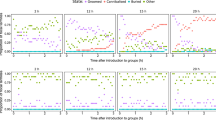Abstract
Social insects employ many types of defense mechanisms against parasites and pathogens because they face high risks from infections due to crowded living conditions with closely related nestmates. Grooming behavior, including self-grooming and allogrooming, can remove fungal spores on the cuticles of social insects and may be a behavioral defense mechanism to improve survivorship. Allogrooming between nestmates has been predicted to be especially important as a defense against ectoparasites. However, little is known about the plasticity of grooming behavior in susceptible environments. Here, we show that the ant Lasius japonicus increases the frequency of allogrooming rather than self-grooming to improve survivorship against the entomopathogenic fungus Metarhizium anisopliae. We found that increasing fungal dosage and ant group size influenced the plasticity of grooming behavior. Additionally, the survival rate of the ants over 30 days improved with increased group size. Our results suggest that social insects opt for altruistic behavior to prevent the spread of diseases. This study illustrates how ants maintain colonies through grooming behavior in the presence of fungal spores.


Similar content being viewed by others
References
Calleri DV, Rosengaus RB, Traniello JFA (2010) Disease resistance in the drywood termite, Incisitermes schwarzi: does nesting ecology affect immunocompetence? J Insect Sci 10 (article 44)
Evans JD, Spivak M (2010) Socialized medicine: individual and communal disease barriers in honey bees. J Invert Pathol 103:S62–S72
Hölldobler B, Wilson EO (1990) The ants. Harvard University Press, Cambridge
Hughes WOH, Boomsma JJ (2004) Genetic diversity and disease resistance in leaf-cutting ant societies. Evolution 58:1251–1260
Hughes WOH, Eilenberg J, Boomsma JJ (2002) Trade-offs in group living: transmission and disease resistance in leaf-cutting ants. Proc R Soc Lond B 269:1811–1819
Jaccoud DB, Hughes WOH, Jackson CW (1999) The epizootiology of a Metarhizium infection in mini-nests of the leaf-cutting ant Atta sexdens rubropilosa. Exp Appl Entomol Exp App 93:51–61
Japanese Ant Database Group (2003) Ants of Japan. Gakken, Tokyo
Naug D, Camazine S (2002) The role of colony organization on pathogen transmission in social insects. J Theor Biol 215:427–439
Oi DH, Pereira RM (1993) Ant behavior and microbial pathogens (Hymenoptera: Formicidae). Fla Entomol 76:63–74
Poulsen M, Bot AN, Nielsen MG, Boomsma JJ (2002) Experimental evidence for the costs and hygienic significance of the antibiotic metapleural gland secretion in leaf-cutting ants. Behav Ecol Sociobiol 52:151–157
Rosengaus RB, Maxmen AB, Coates LE, Traniello JFA (1998) Disease resistance: a benefit of sociality in the dampwood termite Zootermopsis angusticollis (Isoptera: Termopsidae). Behav Ecol Sociobiol 44:125–134
Schmid-Hempel P (1998) Parasites in social insects: monographs in behavior and ecology. Princeton University Press, Princeton
Shimizu S, Yamaji M (2003) Effect of density of the termite, Reticulitermes speratus Kolbe (Isoptera: Rhinotermitidae), on the susceptibilities to Metarhizium anisppliae. Appl Entomol Zool 38:125–130
Traniello JFA, Rosengaus RB, Savoie K (2002) The development of immunity in a social insect: evidence for the group facilitation of disease resistance. Proc Natl Acad Sci USA 99:6838–6842
Ugelvig LV, Cremer S (2007) Social prophylaxis: group interaction promotes collective immunity in ant colonies. Curr Biol 171:1967–1971
Yanagawa A, Shimizu S (2005) Defense strategy of the termite, Copototermes formosanus Shiraki to entomopathogenic fungi. Jpn J Environ Entomol Zool 16:17–22
Yanagawa A, Yokohari F, Shimizu S (2009) The role of antennae in removing entomopathogenic fungi from cuticle of the termite, Coptotermes formosanus. J Insect Sci 9:1–9
Acknowledgments
We thank Dr. Takayoshi Nishida and members of our laboratory for helpful comments and critical remarks on an early draft of the manuscript. The paper was improved by the comments of Dr. Kenji Matsuura. This work was supported in part by the 21st century COE program for Innovative Food and Environmental Studies Pioneered by Entomomimetic Sciences from the Ministry of Education, Culture, Sports, Science and Technology, Japan.
Author information
Authors and Affiliations
Corresponding author
About this article
Cite this article
Okuno, M., Tsuji, K., Sato, H. et al. Plasticity of grooming behavior against entomopathogenic fungus Metarhizium anisopliae in the ant Lasius japonicus . J Ethol 30, 23–27 (2012). https://doi.org/10.1007/s10164-011-0285-x
Received:
Accepted:
Published:
Issue Date:
DOI: https://doi.org/10.1007/s10164-011-0285-x




